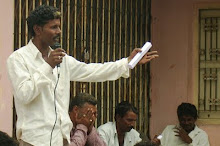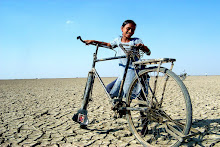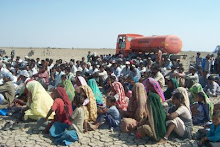Down to Earth: New Delhi: Wednesday, 15 December 2021.
In this first part of a three-part series, here is a look at how Agariya salt workers in the Little Rann of Kutch transformed their lives by using solar pumps to pump brine
Kanuben Patadia looks at her palms and remembers the time when they used to be coated in soot all the time. All her life Kanuben has been making something none of us can live without salt. But it is only in the last six years that her hands have been this clean, she smiles and tells us.
Now, she also has a ‘dish’ under which the family sits to take a break from the hard work and blazing sun. In Gujarat’s Little Rann of Kutch, where vast cracked land stretches into the horizon with no trees in site, the ‘dish’ has become a reason for Kanuben’s clean hands. The horizon is dotted with grey rectangular solar panels every few kilometres and the scorching sun is a source of joy.
The ‘dish’ has also brought her out of a never-ending debt trap, helped her built a pukka house back in her village, marry off her son and buy jewellery worth Rs 2.5 lakh, something she had only dreamt off.
“There was a time when we returned from the Rann with negative savings. To pay the loan back at the end of the season, we worked at the ‘Ganja’ (site where salt is loaded, iodised and packed to be transported to other parts of the country) where we were paid 18 paise per tonne to load salt in trucks,” she reminisced.
India is the third-largest producer of salt globally after the United States and China. Agariyas, the salt farmers of the Little Rann of Kutch (LRK), produce 30 per cent of India’s inland salt — about 0.35 million metric tonnes.
The Agariyas produce salt from underground brine that has extensive reserves in the region, thanks to its hydro-geological formation, unlike the sea salt industry.
The brine is pumped out and spread in large pans to evaporate to make crystal salt. Thirteen years ago, when this reporter first visited LRK, light diesel oil (locally know as crude) pumps were used 24x7 to lift this sub-soil brine.
The pump was placed besides the temporary hut of an Agariya, making the noxious fumes and noise from the pump a constant in his life. The fuel constituted 70 per cent of his input cost for making salt.
The price the Agariya got for his salt back then was 7 paisa per kg as against the market rate of Rs 10-15. The retail rate has now gone up to Rs 15-20 per kg but the Agariya continues to be paid just one per cent of it.
Non-profits working with the Agariyas did a few trials and came up with solar pumps in 2008 to suit the region’s requirement.
Non-profits operating in LRK claim that 80 per cent of the 7,000 Agariya families in LRK now have at least one solar pump though there is no official data on the same.
LRK’s topography
The 5,000 square kilometres of LRK is a saucer-shaped region that remains a desert for eight months.
It becomes a brackish water lake in the four months of the southwest monsoon. That is when 11 rivers from Saurashtra, North Gujarat and Rajasthan drain here, combining with tidal waters from the Arabian Sea that enter the region via a creek.
The LRK, surrounded by five districts of Gujarat, is a wildlife sanctuary to conserve the endemic wild ass. Temperature here varies from 0 degrees in the winters to a scalding 50 degrees Celsius in summers.
When the monsoon water dries off in October-end, Agariya families from 106 villages in five districts around LRK migrate inside with survival essentials.
They set up their huts, dig up wells to extract brine and prepare a series of four-five pans — smaller ones for concentration of brine and the largest one for crystallisation of salt.
The entire process is manual except for the pump that lifts the brine. Traditionally, the salt workers took an advance loan from local traders to pay for upcoming expenditures like repair and maintenance of pumps, diesel, transportation of potable water to the Rann and daily needs.
The loan also means committing the final product to the trader at a prefixed price, much like the middleman system in agriculture.
However, with increasing fuel costs every year, the Agariya would mostly go home with very little or sometimes negative savings at the end of the season.
Sixty-year-old Tejal Makwana saw her grandfather pumping brine by bullocks. She has seen a belt-driven pump, a diesel generator and now a solar pump in her 40 years of married life.
“By far, this has been the best. We needed 13 drums of oil before we got solar pumps in 2016. Each drum of 200 litres oil cost us Rs 10,000 back then. Now, we only need seven drums to run the pump for a few hours in the night. The sun is enough during the day,” Makwana, who hails from Junagaon in Patdi block of Surendranagar district, said.
She now gets to take home around Rs 2 lakh at the end of the season after expenses on fuel, food, maintenance of the equipment and transportation of water and other essentials inside the Rann.
Lack of potable water and no toilets in the Rann means a hard life, especially for women. Kanuben’s husband Kantibhai bought a bike with his savings after solar pumps came. Now, Kanuben gets to go back to her village twice a month for bath, a luxury in this region.
Premji Kutecha from Tikar village in Halvad block was one of the pioneers to install a solar pump in 2010. His family has not migrated to the Rann for five years now.
His wife and three daughters-in-law stay back in the village while the men go to the Rann in the morning, finish the day’s work and come back to the village by evening.
Kutecha now has four solar pumps, one each in his and his three sons’ name and has stopped using diesel completely.
“I could not educate my sons, now at least my grandchildren are in a stable environment and getting a good education,” said Kutecha.
Kutecha, with his savings in the last 11 years, paid off his loan for solar pumps, bought a four-wheeler for the family, a plot of land where he is constructing a new house and saved Rs 10 lakh.
Many Agariyas, especially those in areas where the water table is low, still use diesel generators in the evening to extract more brine and also for lighting their huts. However, not having to use it in the day has led to convenience.
A diesel pump has to be monitored 24X7 as the motor can heat up and burst.
“An Agariya died last year when the motor burst just when he went to switch it off, the metallic parts piercing his body,” Bharat Somera, Surendranagar district coordinator of the Agariya Hitrakshak Manch (AHRM), a non-profit that works with salt farmers in LRK.
“Because they do not have to monitor the pump all the time, the parents are spending more time with children and also mingling with other families in their hamlet in the Rann. Recently, a girl took up the job to make midday meals in the Rann Shala (tented classrooms for younger Agariya children that the government has set up) because she had the spare time to do so, thanks to solar pump,” Bhavna Harchandani, a research scholar from IIT-Gandhinagar, doing her study on the life of Agariyas, said.
Agariyas are also putting their children in hostels with decreased workload. “Many more Agariya children have cleared Grade 10 in the last few years,” Somera said.
Monetary savings has changed the equation of Agariyas with the trader, Pankti Jog of AHRM, said.
“They still take an advance from the trader but earlier, they were like bonded labour, meekly giving in to any price the trader would fix. Now, the Agariya looks him eye-to-eye and negotiates the price of salt,” she said.
The traders recognise that solar pumps is a win-win for all.
“With the current fuel prices, salt making in LRK would have been unsustainable. Solar came just in time to prevent the Agariyas and the salt industry from dying. Combined with good prices in the last two years (rates have gone up from Rs 250 to Rs 380 per tonne), the Agariya has got better savings,” KD Desai, a trader at Kharagoda, the point where salt is brought for further processing and loading into trains, said.
In this first part of a three-part series, here is a look at how Agariya salt workers in the Little Rann of Kutch transformed their lives by using solar pumps to pump brine
Kanuben Patadia looks at her palms and remembers the time when they used to be coated in soot all the time. All her life Kanuben has been making something none of us can live without salt. But it is only in the last six years that her hands have been this clean, she smiles and tells us.
Now, she also has a ‘dish’ under which the family sits to take a break from the hard work and blazing sun. In Gujarat’s Little Rann of Kutch, where vast cracked land stretches into the horizon with no trees in site, the ‘dish’ has become a reason for Kanuben’s clean hands. The horizon is dotted with grey rectangular solar panels every few kilometres and the scorching sun is a source of joy.
The ‘dish’ has also brought her out of a never-ending debt trap, helped her built a pukka house back in her village, marry off her son and buy jewellery worth Rs 2.5 lakh, something she had only dreamt off.
“There was a time when we returned from the Rann with negative savings. To pay the loan back at the end of the season, we worked at the ‘Ganja’ (site where salt is loaded, iodised and packed to be transported to other parts of the country) where we were paid 18 paise per tonne to load salt in trucks,” she reminisced.
India is the third-largest producer of salt globally after the United States and China. Agariyas, the salt farmers of the Little Rann of Kutch (LRK), produce 30 per cent of India’s inland salt — about 0.35 million metric tonnes.
The Agariyas produce salt from underground brine that has extensive reserves in the region, thanks to its hydro-geological formation, unlike the sea salt industry.
The brine is pumped out and spread in large pans to evaporate to make crystal salt. Thirteen years ago, when this reporter first visited LRK, light diesel oil (locally know as crude) pumps were used 24x7 to lift this sub-soil brine.
The pump was placed besides the temporary hut of an Agariya, making the noxious fumes and noise from the pump a constant in his life. The fuel constituted 70 per cent of his input cost for making salt.
The price the Agariya got for his salt back then was 7 paisa per kg as against the market rate of Rs 10-15. The retail rate has now gone up to Rs 15-20 per kg but the Agariya continues to be paid just one per cent of it.
Non-profits working with the Agariyas did a few trials and came up with solar pumps in 2008 to suit the region’s requirement.
Non-profits operating in LRK claim that 80 per cent of the 7,000 Agariya families in LRK now have at least one solar pump though there is no official data on the same.
LRK’s topography
The 5,000 square kilometres of LRK is a saucer-shaped region that remains a desert for eight months.
It becomes a brackish water lake in the four months of the southwest monsoon. That is when 11 rivers from Saurashtra, North Gujarat and Rajasthan drain here, combining with tidal waters from the Arabian Sea that enter the region via a creek.
The LRK, surrounded by five districts of Gujarat, is a wildlife sanctuary to conserve the endemic wild ass. Temperature here varies from 0 degrees in the winters to a scalding 50 degrees Celsius in summers.
When the monsoon water dries off in October-end, Agariya families from 106 villages in five districts around LRK migrate inside with survival essentials.
They set up their huts, dig up wells to extract brine and prepare a series of four-five pans — smaller ones for concentration of brine and the largest one for crystallisation of salt.
The entire process is manual except for the pump that lifts the brine. Traditionally, the salt workers took an advance loan from local traders to pay for upcoming expenditures like repair and maintenance of pumps, diesel, transportation of potable water to the Rann and daily needs.
The loan also means committing the final product to the trader at a prefixed price, much like the middleman system in agriculture.
However, with increasing fuel costs every year, the Agariya would mostly go home with very little or sometimes negative savings at the end of the season.
Sixty-year-old Tejal Makwana saw her grandfather pumping brine by bullocks. She has seen a belt-driven pump, a diesel generator and now a solar pump in her 40 years of married life.
“By far, this has been the best. We needed 13 drums of oil before we got solar pumps in 2016. Each drum of 200 litres oil cost us Rs 10,000 back then. Now, we only need seven drums to run the pump for a few hours in the night. The sun is enough during the day,” Makwana, who hails from Junagaon in Patdi block of Surendranagar district, said.
She now gets to take home around Rs 2 lakh at the end of the season after expenses on fuel, food, maintenance of the equipment and transportation of water and other essentials inside the Rann.
Lack of potable water and no toilets in the Rann means a hard life, especially for women. Kanuben’s husband Kantibhai bought a bike with his savings after solar pumps came. Now, Kanuben gets to go back to her village twice a month for bath, a luxury in this region.
Premji Kutecha from Tikar village in Halvad block was one of the pioneers to install a solar pump in 2010. His family has not migrated to the Rann for five years now.
His wife and three daughters-in-law stay back in the village while the men go to the Rann in the morning, finish the day’s work and come back to the village by evening.
Kutecha now has four solar pumps, one each in his and his three sons’ name and has stopped using diesel completely.
“I could not educate my sons, now at least my grandchildren are in a stable environment and getting a good education,” said Kutecha.
Kutecha, with his savings in the last 11 years, paid off his loan for solar pumps, bought a four-wheeler for the family, a plot of land where he is constructing a new house and saved Rs 10 lakh.
Many Agariyas, especially those in areas where the water table is low, still use diesel generators in the evening to extract more brine and also for lighting their huts. However, not having to use it in the day has led to convenience.
A diesel pump has to be monitored 24X7 as the motor can heat up and burst.
“An Agariya died last year when the motor burst just when he went to switch it off, the metallic parts piercing his body,” Bharat Somera, Surendranagar district coordinator of the Agariya Hitrakshak Manch (AHRM), a non-profit that works with salt farmers in LRK.
“Because they do not have to monitor the pump all the time, the parents are spending more time with children and also mingling with other families in their hamlet in the Rann. Recently, a girl took up the job to make midday meals in the Rann Shala (tented classrooms for younger Agariya children that the government has set up) because she had the spare time to do so, thanks to solar pump,” Bhavna Harchandani, a research scholar from IIT-Gandhinagar, doing her study on the life of Agariyas, said.
Agariyas are also putting their children in hostels with decreased workload. “Many more Agariya children have cleared Grade 10 in the last few years,” Somera said.
Monetary savings has changed the equation of Agariyas with the trader, Pankti Jog of AHRM, said.
“They still take an advance from the trader but earlier, they were like bonded labour, meekly giving in to any price the trader would fix. Now, the Agariya looks him eye-to-eye and negotiates the price of salt,” she said.
The traders recognise that solar pumps is a win-win for all.
“With the current fuel prices, salt making in LRK would have been unsustainable. Solar came just in time to prevent the Agariyas and the salt industry from dying. Combined with good prices in the last two years (rates have gone up from Rs 250 to Rs 380 per tonne), the Agariya has got better savings,” KD Desai, a trader at Kharagoda, the point where salt is brought for further processing and loading into trains, said.
















.jpg)
.jpg)
.jpg)
.jpg)













No comments:
Post a Comment